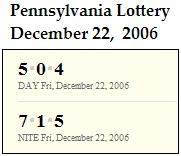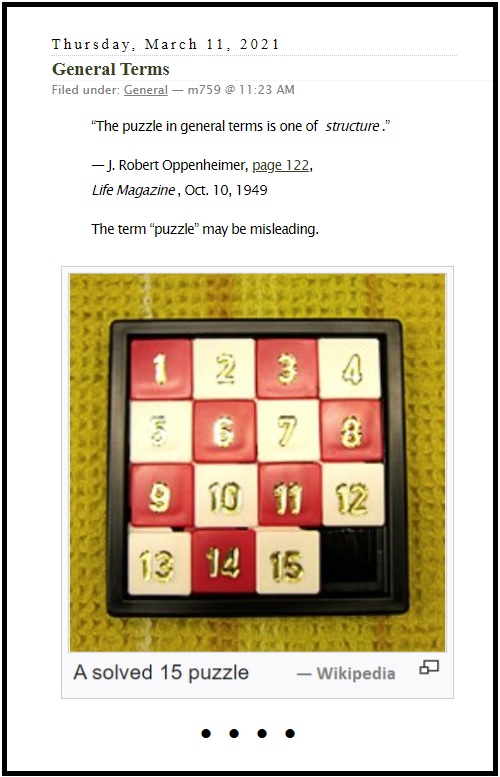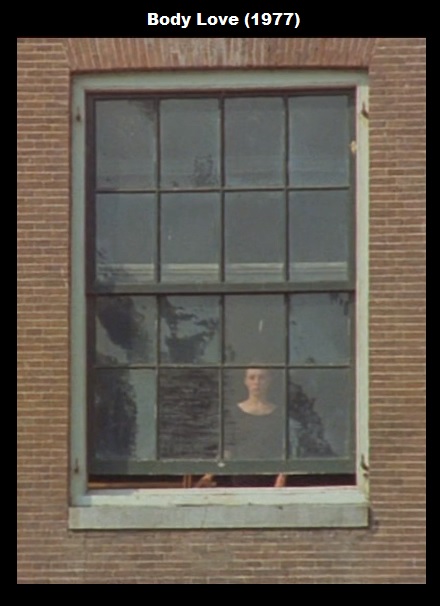
Monday, March 10, 2025
Speak, Memory
Saturday, February 18, 2023
Probing the Wormhole
In memory of illustrator Istvan Banyai,
who reportedly died on Dec. 15, 2022 . . .
https://www.nytimes.com/2023/02/18/
arts/istvan-banyai-dead.html —
Saturday, December 17, 2022
Friday, December 16, 2022
“Can’t Remember Where or When” — Song Lyric
|
When?
Going to dark bed there was a square round Where?
— Ulysses , conclusion of Chapter 17. |
Thursday, December 15, 2022
Saturday, October 6, 2012
Black March
|
Log24, Dec. 18, 2006: “I did a column in Scientific American on minimal art, “… the entire profession has received a very public |
Related posts— See "Bad Black Mark" in this journal.
See also two items from St. Patrick's Day, March 17, 2005—
Click McCarthy photo for some more recent material.
Friday, September 17, 2010
Fade to Blacker
From Peter J. Cameron's web journal today—
|
… Eliot’s Four Quartets has been one of my favourite works of poetry since I was a student…. Of course, a poem doesn’t have a single meaning, especially one as long and complex as Four Quartets. But to me the primary meaning of the poem is about the relationship between time and eternity, which is something maybe of interest to mathematicians as well as to mystics. Curiously, the clearest explanation of what Eliot is saying that I have found is in a completely different work, Pilgrimage of Dreams by the artist Thetis Blacker, in which she describes a series of dreams she had which stood out as being completely different from the confusion of normal dreaming. In one of these dreams, “Mr Goad and the Cathedral”, we find the statements
and
In other words, eternity is not the same as infinity; it is not the time line stretched out to infinity. Rather, it is an intimation of a different dimension, which we obtain only because we are aware of the point at which that dimension intersects the familiar dimension of time. In a recurring motif in the second Quartet, “East Coker”, Eliot says,
and, in “Little Gidding”,
|
From this journal on the date of Blacker's death—
what would, if she were a Catholic saint, be called her dies natalis—
Monday December 18, 2006
|
Saturday, December 23, 2006
Saturday December 23, 2006
Bernard Holland in The New York Times on Monday, May 20, 1996:
“Philosophers ponder the idea of identity: what it is to give something a name on Monday and have it respond to that name on Friday….”
|
Log24 on Monday,
Dec. 18, 2006: “I did a column in — Martin Gardner (pdf) “… the entire profession — Joan S. Birman (pdf)
Lottery on Friday,
Dec. 22, 2006:
 |
5/04, 2005:
Analysis of the structure
of a 2x2x2 cube

projective points
in a Fano plane.
“Art history was very personal
through the eyes of Ad Reinhardt.”
— Robert Morris,
Smithsonian Archives
of American Art
a quotation on Usenet:
“A set having three members is a
single thing wholly constituted by
its members but distinct from them.
After this, the theological doctrine
of the Trinity as ‘three in one’
should be child’s play.”
— Max Black,
Caveats and Critiques:
Philosophical Essays in
Language, Logic, and Art
Monday, December 18, 2006
Monday December 18, 2006
continued
“I did a column in Scientific American on minimal art, and I reproduced one of Ed Rinehart’s [sic] black paintings. Of course, it was just a solid square of pure black.”
The Notices of the American Mathematical Society, January 2007 (pdf):
“This was just one of the many moments in this sad tale when there were no whistle-blowers. As a result the entire profession has received a very public and very bad black mark.”
— Joan S. Birman
Professor Emeritus of Mathematics
Barnard College and
Columbia University












